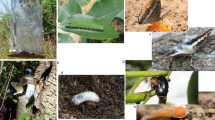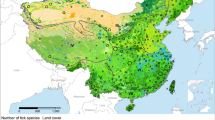Abstract
TSETSE flies are a major constraint on animal production in about 10 million km2 of Africa through their transmission of animal trypanosomiasis1. Up to 25 million people are at risk from human trypanosomiasis, or sleeping sickness2. Tsetse research has been concentrated on the factors that control the distribution and abundance of these vectors and the means by which their numbers can be reduced3. Eradication successes in some countries are insignificant compared with the continental scale of the problem and the long-term reduction in the area infested by tsetse has been negligible4. We report here that the mortality rates of tsetse from sites in both West and East Africa, the size of male and female tsetse (related to the mortality rate of the parental female population) along a north–south transect in West Africa, and the abundance of two species of tsetse over the northern half of Côte d'lvoire, are significantly correlated with data from meteorological satellites. This information could be used to predict both the mortality rate and the abundance (key determinants of disease transmission potential) of tsetse over very large areas of the continent and to produce maps of high risk areas of disease transmission for the African trypanosomiases and, by implication, for many other vector-borne diseases.
This is a preview of subscription content, access via your institution
Access options
Subscribe to this journal
Receive 51 print issues and online access
$199.00 per year
only $3.90 per issue
Buy this article
- Purchase on Springer Link
- Instant access to full article PDF
Prices may be subject to local taxes which are calculated during checkout
Similar content being viewed by others
References
Murray, M. & Gray, A. R. Prev. vet. Med 2, 23–30 (1984).
De Muynck, A. & Rogers, D. J. (eds) Ann. Soc. Beige Méd. trop. 69, (1989).
Mulligan, H. W. (ed.). The African Trypanosomiases (Allen & Unwin, London, 1970).
Rogers, D. J. & Randolph, S. E. J. Anim. Ecol. 55, 1007–1025 (1986).
Moran, P. A. P., Biometrics 6, 250–258 (1950).
Buxton, P. A. London School of Hygiene & Tropical Medicine, Memoir 10 (Lewis, London 1955).
Rogers, D. J. J. Anim. Ecol. 48, 825–849 (1979).
Varley, G. C., Gradwell, G. R. & Hassell, M. P. Insect Population Ecology (Blackwell Scientific, Oxford, 1973).
HMSO Tables of Temperature, Relative Humidity, Precipitation and Sunshine for the World, Part 4 (HMSO, London, 1983).
Barrett, E. C. & D'Souza, G. Proc. 20th Int. Symp. Rem. Sens. Env., Nairobi, Kenya 3, 955–964 (1986).
Milford, J. R. & Dugdale, G. Rainfall mapping over West Africa in 1986 (Dept Meteorology, Univ Reading, 1986).
Tucker, C. J. & Sellers, P. J. Int. J. Rem. Sens. 7, 1395–1416 (1986).
Tucker, C. J., Townshend, J. R. G. & Goff, T. E. Science 227, 369–375 (1985).
Hueten, A. R. & Jackson, R. D. Remn. Sens. Env. 23, 213–232 (1987).
Bartholomé, E. Int. J. Rem. Sens. 9, 1539–1552 (1988).
Hutchinson, C, F. Int. J. Rem. Sens. (in the press).
Hielkema, J. U., Roffey, J. & Tucker, C. J. Int. J. Rem. Sens. 7, 1609–1622 (1986).
Linthicum, K. J., Bailey, C. L., Davies, F. G. & Tucker, C. J. Science 235, 1656–1659 (1987).
Washino, R. K., Pitcairn, M. J. & Rejimankova, E., Mosquito Control Research 1987 A. Rep. (Univ. California, Division of Agriculture & Natural Resources, 1987).
Hugh-Jones, M. E. et al. Acta Vet. Scand 84 (Suppl), 256–261 (1988).
Cross, E. R. & Bailey, R. C. Milit. Med. 149, 28–30 (1984).
Bourn, D., thesis, Oxford Univ., 1983.
Avery, M. I. & Haines-Young, R. H. Nature 344, 860–862 (1990).
Ford, J. & Katondo, K. M. The Distribution of Tsetse Flies in Africa (OAU/Cook, Hammond & Kell, London, 1977).
Nicholson, S. E., Davenport, M. L. & Malo, A. R. Climatic Change 17, 209–241 (1990).
Challier, A. & Laveissière, C. Cah. ORSTOM Sér. Entomol. méd Parasitol. 11, 251–262 (1973).
Randolph, S. E. & Rogers, D. J. Bull. ent. Res. 68, 655–671 (1978).
Dransfield, R. D., Brightwell, R., Kiilu, J., Chaudhury, M, F. & Adabie, D. A. Med. vet. Ent. 3, 83–95 (1989).
FAO/GTZ Cartographie de la Repartition des Glossines (IEMVT, Maisons Alfort, France, 1982).
Rogers, D. J. & Randolph, S. E. Insect Sci. Applic. 5, 397–402 (1984).
Rogers, D. J. Parasitology 97, 193–212 (1988).
Author information
Authors and Affiliations
Rights and permissions
About this article
Cite this article
Rogers, D., Randolph, S. Mortality rates and population density of tsetse flies correlated with satellite imagery. Nature 351, 739–741 (1991). https://doi.org/10.1038/351739a0
Received:
Accepted:
Issue Date:
DOI: https://doi.org/10.1038/351739a0
This article is cited by
-
Seroprevalence of Trypanosoma evansi in cattle and analysis of associated climatic risk factors in Mizoram, India
Journal of Parasitic Diseases (2021)
-
A review: application of remote sensing as a promising strategy for insect pests and diseases management
Environmental Science and Pollution Research (2020)
-
Spatial distribution modelling of Culicoides (Diptera: Ceratopogonidae) biting midges, potential vectors of African horse sickness and bluetongue viruses in Senegal
Parasites & Vectors (2018)
-
Is body size important? Seasonal changes in morphology in two grass-feeding Abacarus mites
Experimental and Applied Acarology (2017)
-
Perspectives on modelling the distribution of ticks for large areas: so far so good?
Parasites & Vectors (2016)
Comments
By submitting a comment you agree to abide by our Terms and Community Guidelines. If you find something abusive or that does not comply with our terms or guidelines please flag it as inappropriate.



